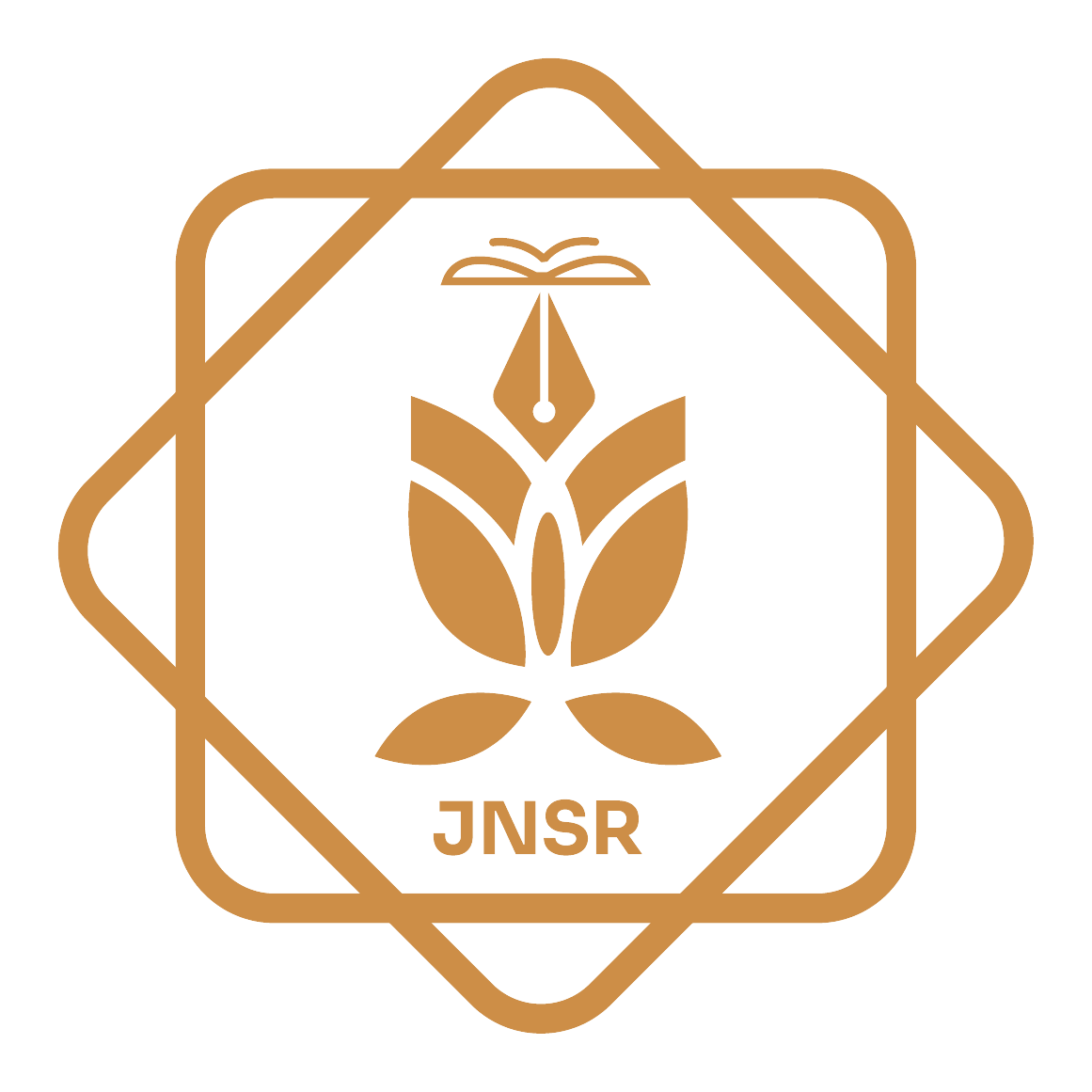Impacts of Humic Acid on Growth and Yield of Wheat: A Review
DOI:
https://doi.org/10.62810/jnsr.v2i3.81Keywords:
Humic acid, Wheat, Wheat growth, Wheat yieldAbstract
Wheat (Triticum aestivum L.) is a crucial crop, providing 20% of caloric intake for many populations worldwide. Soil organic matter, an essential component of soil, directly influences soil fertility and texture. Humic substances, derived from biomolecules' physical, chemical, and microbiological transformation, are integral to soil humus. Humic acid has become a standard method for enhancing crop growth, yield, and soil fertility. While the effects of humic acid on wheat have been extensively studied, the optimal type and application method for wheat cultivation remain undetermined. This review investigates sustainable wheat production methods using humic acid to mitigate the negative impacts of chemical fertilizers and climate change factors. Research indicates that humic acid significantly increases wheat plant growth parameters: shoot length (18%), root length (29%), shoot dry weight (76%), root dry weight (100%), and chlorophyll content (96%). Moreover, humic acid substantially improves wheat yield and yield components, including spike length (14.66%), number of spikes per square meter (28.73%), number of spikelets per spike (23.52%), and 1000-grain weight (23.90%). As a sustainable organic substance, humic acid application offers a promising approach to improving wheat production. This method could help meet the food demands of the growing global population, particularly in countries like Afghanistan, where food security is a pressing concern.
Downloads
References
Ahmad, T., Khan, R., & Nawaz Khattak, T. (2018). Effect of humic acid and fulvic acid based liquid and foliar fertilizers on wheat crop yield. Journal of Plant Nutrition, 41(19), 2438–2445. https://doi.org/10.1080/01904167.2018.1527932 DOI: https://doi.org/10.1080/01904167.2018.1527932
Alfatlawi, Z. H. C., & and Alrubaiee, S. H. A. W. (2020). Effects of spraying different concentrations of Humic acid on the growth and yield of wheat crop ( IP99 cultivar) in various stages. Plant Archives, 20(2), 1517–1521.
Arjumend, T., Abbasi, M. K., & Rafique, E. (2015). Effects of lignite-derived Humic acid on some selected soil properties, growth, and nutrient uptake of wheat (Triticum Aestivum L.) grown under greenhouse conditions. In Pakistan Journal of Botany,47(6), 2231–2238.
Awad, A. A. ., El-Taib, A. B. ., Sweed, A. A. ., & and Omran, A. A. . et al. (2022). Nutrient Contents and Productivity of Triticum aestivum Plants Grown in Clay Loam Soil Depending on Humic Substances and Varieties and Their Interactions Ahmed. Agronomy, 12(705). DOI: https://doi.org/10.3390/agronomy12030705
Dinçsoy, M., & Sönmez, F. (2019). The effect of potassium and humic acid applications on yield and nutrient contents of wheat (Triticum aestivum L. var. Delfii) with same soil properties. Journal of Plant Nutrition, 42(20), 2757–2772. https://doi.org/10.1080/01904167.2019.1658777 DOI: https://doi.org/10.1080/01904167.2019.1658777
Ehsan, S., Javed, S., Saleem, I., & Niaz, A. (2016). Effect of Humic Acid on Micronutrient Availability and Grain Yield of Wheat ( Triticum Aestivum L .). Journal of Agriculture Research, 54(2), 173–184.
El-Hashash, E. F., El-Enin, M. M. A., El-Mageed, T. A. A., Attia, M. A. E. H., El-Saadony, M. T., El-Tarabily, K. A., & Shaaban, A. (2022). Bread Wheat Productivity in Response to Humic Acid Supply and Supplementary Irrigation Mode in Three Northwestern Coastal Sites of Egypt. Agronomy, 12(7). https://doi.org/10.3390/agronomy12071499 DOI: https://doi.org/10.3390/agronomy12071499
Gao, S., Zhang, S., Yuan, L., Li, Y., Wen, Y., Xu, J., Hu, S. & Zhao, B. (2022). Humic acids Incorporated into Urea at Different Proportions Increased Winter Wheat Yield and Optimized Fertilizer-Nitrogen Fate. Agronomy, 12(1526). DOI: https://doi.org/10.3390/agronomy12071526
Gomaa, M. A., Rehab, I. F., & Adam, I. A. (2015). Impact of Humic acid Application , Foliar Micronutrients and Biofertilization on Growth , Productivity and Quality of Wheat (Triticum aestivum , L .). Middle East Journal of Agriculture Research, 4(02), 130–140.
Iqbal, B., Anwar, S., Iqbal, F., Khatak, W. A., Islam, M., & and Khan, S. (2016). Response of Wheat Crop to Humic acid and Nitrogen Levels.Ecronocon Agriculture, 3(1), 558–565.
Khaled, H., & Fawy, H. A. (2011). Effect of Different Levels of Humic acids on the Nutrient Content, Plant Growth, and Soil Properties under Conditions of Salinity. Soil and Water Research, 6(1), 21–29. DOI: https://doi.org/10.17221/4/2010-SWR
Khan, R. U., Khan, M. Z., Khan, A., Saba, S., Hussain, F., & Jan, I. U. (2018). Effect of humic acid on growth and crop nutrient status of wheat on two different soils. Journal of Plant Nutrition, 41(4) ,453–460. https://doi.org/10.1080/01904167.2017.1385807 DOI: https://doi.org/10.1080/01904167.2017.1385807
Khan, Rahmat Ullah, Rashid, A., Khan, M. S., & Ozturk, and E. (2010). Impact of Humic acid and Cheimical fertilizer application on growth and grain yield of fainfed wheat (Triticum Aestivium L.). Pakistan Journal of Agriculture Research, 23(3–4), 113–121.
Mindari, W., Sasongko, P. E., Kusuma, Z., Syekhfani, & Aini, N. (2019). Efficiency of Various Sources and Doses ofHumic acid on Physical and Chemical Properties of Saline Soil and Growth and Yield of Rice. AIP Conference Proceedings. DOI: https://doi.org/10.1063/1.5061854
Noroozisharaf, A., & Kaviani, M. (2018). Effect of soil application of humic acid on nutrients uptake, essential oil, and chemical compositions of garden thyme (Thymus vulgaris L.) under greenhouse conditions. Physiol Mol Bio Plants, 24(3), 423–431. DOI: https://doi.org/10.1007/s12298-018-0510-y
Pacuta, V., Rašovský, M., Michalska-Klimczak, B., & Wyszynski, Z. (2021). Grain Yield and Quality Traits of Durum Wheat. In Agronomy, 11(1270). DOI: https://doi.org/10.3390/agronomy11071270
Popal, N. A. (2024). Comparative Efficacy of the Weed Management Practices on Grain and Straw Yeilds of Wheat. Journal of Natural Science Review, 2(1), 46–56. DOI: https://doi.org/10.62810/jnsr.v2i1.20
Saha, R., Saieed, M. A. U., & Chowdhury, M. A. K. (2013). Growth and Yield of Rice (Oryza sativa) as Influenced by Humic Acid and Poultry Manure. Universal Journal of Plant Science, 1(3), 78–84. DOI: https://doi.org/10.13189/ujps.2013.010304
Salihi, M. S. (2024). Effects of Elevated CO2 on Rice Seedling Establishment of MR219 and Sri Malaysia1 Varieties. Pakistan Journal of Botany, 56(3), 1–6. DOI: https://doi.org/10.30848/PJB2024-3(5)
Salihi, M. S., M.S., A.-H., & and Jusoh M. et al. (2023). The Impact of Carbon Dioxide (CO2) Enrichment on Rice (Orysia sativa L.) Production: A review . Pakistan Journal of Botany, 3(15). https://doi.org/http://dx.doi.org/10.30848/PJB2023-3(15) DOI: https://doi.org/10.30848/PJB2023-3(15)
Shafi, M. I., Adnan, M., Fahad, S., Wahid, F., Khan, A., Yue, Z., Danish, S., Zafar-Ul-Hye, M., Brtnicky, M., & Datta, R. (2020). Application of single superphosphate with humic acid improves the growth, yield and phosphorus uptake of wheat (Triticum aestivum L.) in calcareous soil. Agronomy ,10(9). https://doi.org/10.3390/agronomy10091224 DOI: https://doi.org/10.3390/agronomy10091224
Sharma, I., Tyagi, B. ., Singh, G., K, V., & and Gupta, O. . (2015). Enhancing wheat production- A global perspective. Indian Journal of Agricultural Sciences, 85(1), 3–13. DOI: https://doi.org/10.56093/ijas.v85i1.45935
Shewry, P. R. (2009). Wheat. Journal of Experimental Botany, 60(6), 1537–1553. https://doi.org/10.1093/jxb/erp058 DOI: https://doi.org/10.1093/jxb/erp058
Tahir, M. M., Khurshid, M., Khan, M. Z., Abbasi, M. K., & Kazmi, M. H. (2011). Lignite-derived humic acid effect on growth of wheat plants in different soils. Pedosphere,21(1), 124–131). https://doi.org/10.1016/S1002-0160(10)60087-2 DOI: https://doi.org/10.1016/S1002-0160(10)60087-2
Zheng, E., Qin, M., Zhang, Z., & Xu, T. (2022). Humic Acid Fertilizer Incorporation Increases Rice Radiation Use, Growth, and Yield: A Case Study on the Songnen Plain, China. Agriculture, 12(653), 1–13. DOI: https://doi.org/10.3390/agriculture12050653
Downloads
Published
How to Cite
Issue
Section
License
Copyright (c) 2024 Mohammad Sadiq Salihi, Hamdullah Hamim, Sultan Mohammad Serat

This work is licensed under a Creative Commons Attribution-NonCommercial 4.0 International License.




























